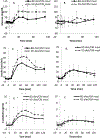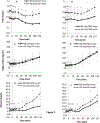Glucose and Lipid Homeostasis and Inflammation in Humans Following an Isocaloric Ketogenic Diet
- PMID: 31067015
- PMCID: PMC6922028
- DOI: 10.1002/oby.22468
Glucose and Lipid Homeostasis and Inflammation in Humans Following an Isocaloric Ketogenic Diet
Abstract
Objective: The objective of this study was to measure changes in glucose, lipid, and inflammation parameters after transitioning from a baseline diet (BD) to an isocaloric ketogenic diet (KD).
Methods: Glucose homeostasis, lipid homeostasis, and inflammation were studied in 17 men (BMI: 25-35 kg/m2 ) during 4 weeks of a BD (15% protein, 50% carbohydrate, 35% fat) followed by 4 weeks of an isocaloric KD (15% protein, 5% carbohydrate, 80% fat). Postprandial responses were assessed following mixed-meal tests matched to compositions of the BD (control meal [CM]) and KD (ketogenic meal).
Results: Fasting ketones, glycerol, free fatty acids, glucagon, adiponectin, gastric inhibitory peptide, total and low-density lipoprotein cholesterol, and C-reactive protein were significantly increased on the KD. Fasting insulin, C-peptides, triglycerides, and fibroblast growth factor 21 were significantly decreased. During the KD, the glucose area under the curve was significantly higher with both test meals, and the insulin area under the curve was significantly higher only for the CM. Analyses of glucose homeostasis suggested that the KD insulin sensitivity decreased during the CM but increased during the ketogenic meal. Insulin-mediated antilipolysis was decreased on the KD regardless of meal type.
Conclusions: Switching to the KD was associated with increased cholesterol and inflammatory markers, decreased triglycerides, and decreased insulin-mediated antilipolysis. Glucose homeostasis parameters were diet dependent and test meal dependent.
Trial registration: ClinicalTrials.gov NCT01967563.
© 2019 The Obesity Society.
Figures


References
-
- Abbasi J Interest in the Ketogenic Diet Grows for Weight Loss and Type 2 Diabetes. JAMA 2018;319: 215–217. - PubMed
-
- Boden G, Sargard K, Homko C, Mozzoli M, Stein T. Effect of a low-carbohydrate diet on appetite, blood glucose levels, and insulin resistance in obese patients with type 2 diabetes. Ann Intern Med 2005;142: 403–411. - PubMed
-
- O’Brien K, Brehm B, Seeley R, Bean J, Wener M, Daniels S, et al. Diet-induced weight loss is associated with decreases in plasma serum amyloid a and c-reactive protein independent of dietary macronutrient composition in obese subjects. J Clin Endocrinol Metab 2005;90: 2244–2249. - PubMed
-
- Hall K A review of the carbohydrate-insulin model of obesity. Eur J Clin Nutr 2017;71: 323–326. - PubMed
Publication types
MeSH terms
Substances
Associated data
Grants and funding
LinkOut - more resources
Full Text Sources
Medical
Research Materials

